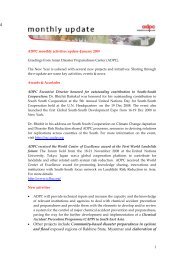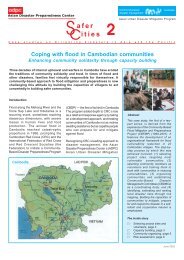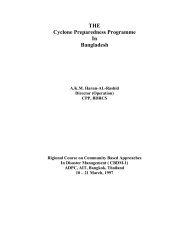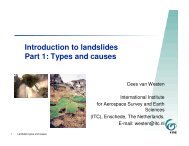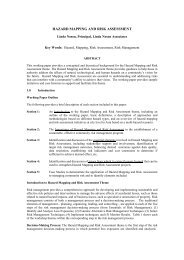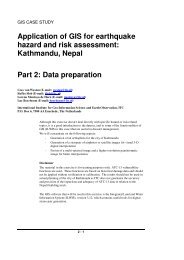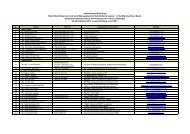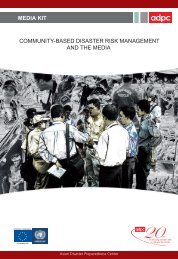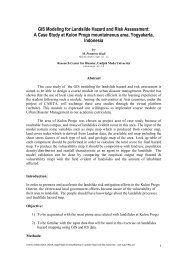Hazard Profile of Myanmar - Asian Disaster Preparedness Center
Hazard Profile of Myanmar - Asian Disaster Preparedness Center
Hazard Profile of Myanmar - Asian Disaster Preparedness Center
Create successful ePaper yourself
Turn your PDF publications into a flip-book with our unique Google optimized e-Paper software.
for the last major earthquake in this segment is 800±200 years. Also, we believed that<br />
there were aseismic movements along the northern Rakhine especially around<br />
Kyaukpyu area thus, the possibility <strong>of</strong> strain accumulation sufficient for large<br />
earthquake is low.<br />
• Possibility <strong>of</strong> strong and major earthquakes along the Sagaing Fault is considerable.<br />
As already described in the text, two important segments <strong>of</strong> the fault (Taungoo - Bago<br />
and Sagaing – Tagaung) displayed no seismic activity for more than half a century.<br />
GPS observations <strong>of</strong> the French-<strong>Myanmar</strong> team showed strain loading in the<br />
Mandalay area (Vigny et al., 2003). Recently, active fault study project in Bago area<br />
detected possibility <strong>of</strong> strain loading in the <strong>of</strong>fset Payagyi ancient city wall to a<br />
certain extent.<br />
• Seismic activity <strong>of</strong> Kyaukkyan – Papun Fault is considerable but the movement along<br />
is too much slower than that <strong>of</strong> the Sagaing Fault. Though the largest magnitude<br />
earthquake <strong>of</strong> <strong>Myanmar</strong> occurred in 1912, the apparent recurrence interval seems to<br />
be more than 200 years (known by checking geomorphic features between Lawksauk<br />
and Inlay Lake by our researchers).<br />
• Possibility <strong>of</strong> moderate to strong earthquakes in central <strong>Myanmar</strong> basin, especially<br />
along the transpressional faults is still high. Strong earthquakes in every two decades<br />
are not negligible at least two thrust fault lines.<br />
4.7 Looking Forward<br />
<strong>Myanmar</strong> is an earthquake-prone country due to its location in the active Alpide<br />
seismotectonic belt, the young Alpine-Himalayan-Sumatran orogenic belt. <strong>Myanmar</strong> forms a<br />
local segment, the <strong>Myanmar</strong> arc, <strong>of</strong> this major arc commonly referred to as the Sunda arc.<br />
The arc has two important tectonic features- earthquake sources, one within <strong>Myanmar</strong> and<br />
the other in her neighbourhood to the west. These are the active Sagaing fault, trending<br />
north – south across the entire length <strong>of</strong> central <strong>Myanmar</strong>, and the Sunda subduction<br />
megathrust zone running through <strong>of</strong>f-shore southwest and west <strong>of</strong> the <strong>Myanmar</strong> coast and<br />
on-land to the west and northwest <strong>of</strong> <strong>Myanmar</strong>. The Sagaing Fault passes through the most<br />
populated areas <strong>of</strong> <strong>Myanmar</strong> where large cities have been built, active fault studies with<br />
characterization <strong>of</strong> earthquake response spectrum on engineering structures and design code<br />
for buildings are necessary.<br />
It is suggested that the following activities should be undertaken to mitigate the seismic<br />
risks.<br />
• Continuation, extension, and expansion <strong>of</strong> the neotectonic and active fault studies<br />
along the Sagaing, Kyaukkyan and Kabaw faults.<br />
<strong>Hazard</strong> pr<strong>of</strong>ile <strong>of</strong> <strong>Myanmar</strong><br />
- 36 -



